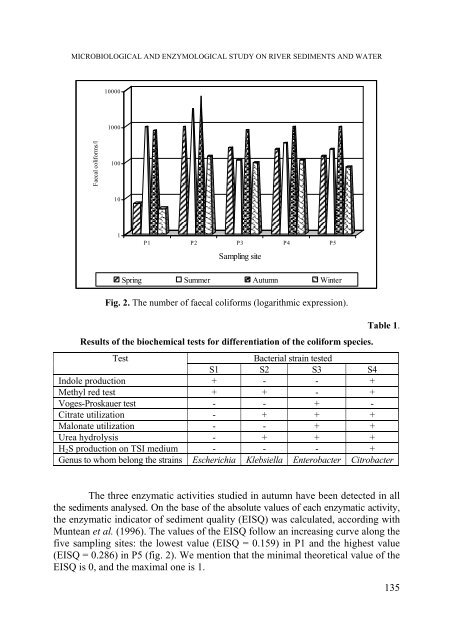biologia - Studia
biologia - Studia
biologia - Studia
You also want an ePaper? Increase the reach of your titles
YUMPU automatically turns print PDFs into web optimized ePapers that Google loves.
MICROBIOLOGICAL AND ENZYMOLOGICAL STUDY ON RIVER SEDIMENTS AND WATER<br />
10000<br />
1000<br />
Faecal coliforms/l<br />
100<br />
10<br />
1<br />
P1 P2 P3 P4 P5<br />
Sampling site<br />
Spring Summer Autumn Winter<br />
Fig. 2. The number of faecal coliforms (logarithmic expression).<br />
Results of the biochemical tests for differentiation of the coliform species.<br />
Table 1.<br />
Test<br />
Bacterial strain tested<br />
S1 S2 S3 S4<br />
Indole production + - - +<br />
Methyl red test + + - +<br />
Voges-Proskauer test - - + -<br />
Citrate utilization - + + +<br />
Malonate utilization - - + +<br />
Urea hydrolysis - + + +<br />
H 2 S production on TSI medium - - - +<br />
Genus to whom belong the strains Escherichia Klebsiella Enterobacter Citrobacter<br />
The three enzymatic activities studied in autumn have been detected in all<br />
the sediments analysed. On the base of the absolute values of each enzymatic activity,<br />
the enzymatic indicator of sediment quality (EISQ) was calculated, according with<br />
Muntean et al. (1996). The values of the EISQ follow an increasing curve along the<br />
five sampling sites: the lowest value (EISQ = 0.159) in P1 and the highest value<br />
(EISQ = 0.286) in P5 (fig. 2). We mention that the minimal theoretical value of the<br />
EISQ is 0, and the maximal one is 1.<br />
135
















